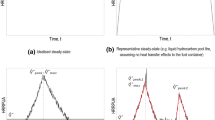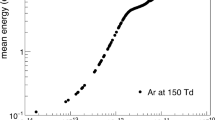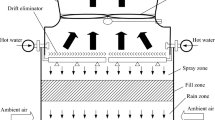Abstract
This paper presents a physical and mathematical models of the problem of forest canopy ignition based on the laws of mechanics of reacting media and the results of numerical calculations of the ignition time and radius of a forest exposed to a thermal radiation source—a fireball resulting from a hydrocarbon explosion. The forest canopy (set of tree crowns) is considered as a homogeneous two-temperature porous reactive medium. Temperature and concentration changes at the upper boundary of the forest canopy from the beginning of its heating to ignition are described.
Similar content being viewed by others
References
“Fire Safety of Technological Processes. General Requirements. Control Methods,” Russian National Standard (GOST) No. R 12.3.047-2012. SSBT, Approved by the Federal Agency for Technical Regulation and Metrology of December 27, 2012, No. 1971-st.
“Risk Analysis Technique for Hazardous Production Facilities of Gazprom Gas Producing Enterprises,” Gazprom Standard No. 2-2.3-400-200 (Inst. of Natural Gases and Gas Technologies, Moscow, 2009).
Method of Assessing Fireproof Distances in the Design of Industrial Enterprises (Federal Center for Regulation, Standardization, Standardization and Technical Conformity Assessment in Construction, Moscow, 2016) [in Russian].
V. Marshall, Major Chemical Hazards (Ellis Horwood, Chichester, 1987).
A. M. Grishin and V. A. Perminov, “Ignition of Forests by a High Altitude Source of Radiant Energy,” Vychisl. Tekhnol. 2(2), 33–43 (1997).
V. A. Perminov, “Mathematical Modeling of the Appearance of Crown and Massive Forest Fires,” Doct. Dissertation in Phys.-Math. Sci. (Tomsk State Univ., Tomsk, 2010).
A. M. Grishin, Mathematical Models of Forest Fires and New Ways of Fighting Them (Nauka, Novosibirsk, 1992) [in Russian].
S. V. Patankar, Numerical Heat Transfer and Fluid Flow (CRC Press, Boca Raton, 1980).
A. M. Grishin, A. D. Gruzin, and V. G. Zverev, “Mathematical Theory of Crown Forest Fires,” in Thermophysics of Forest Fires (Inst. Thermophysics, Siberian Branch, USSR Academy of Sciences, Novosibirsk, 1984) [in Russian].
A. S. Monin and A. M. Yaglom, Statistische Hydromechanik. 1. Mechanik der Turbulenz (Verlag-Nauka, Moskau, 1965).
Author information
Authors and Affiliations
Corresponding authors
Additional information
Original Russian Text © E. Altamirova, V.A. Perminov.
Published in Fizika Goreniya i Vzryva, Vol. 55, No. 5, pp. 67–72, September–October, 2019.
Rights and permissions
About this article
Cite this article
Altamirova, E., Perminov, V.A. Mathematical Modeling of Forest Canopy Ignition by Thermal Radiation from a Hydrocarbon Explosion. Combust Explos Shock Waves 55, 574–579 (2019). https://doi.org/10.1134/S0010508219050083
Received:
Revised:
Accepted:
Published:
Issue Date:
DOI: https://doi.org/10.1134/S0010508219050083




